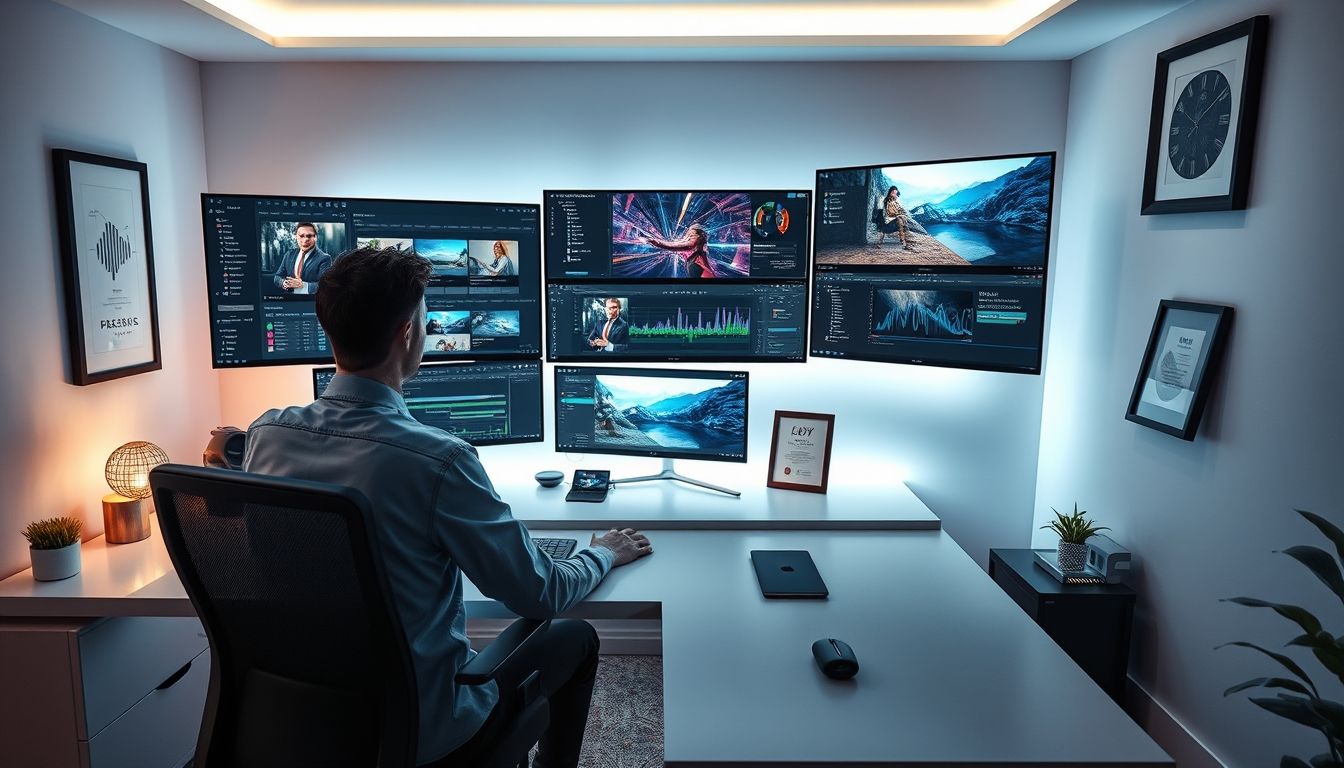Video Editing & Montage: A Golden Opportunity for Investment and Freelancing in the Age of Visual Content
Our world is undergoing a radical shift towards visual content, with videos becoming the preferred medium for communication, education, marketing, and entertainment. This transformation has created a growing demand for professional video editors and montage artists, making this field a golden opportunity for investment and freelancing.
Chapter 1: Why Video Editing and Montage is a Promising Investment Opportunity?
Increasing Demand: With the proliferation of video platforms such as YouTube, TikTok, and Instagram, as well as companies using videos for marketing and training, the demand for professional video editors is increasing significantly.
Low Startup Costs: Compared to many other ventures, video editing does not require a large investment. You can start with a mid-range computer and professional editing software at affordable prices or even free.
Flexibility and Freedom: Working in video editing allows the freedom to work from anywhere and at any time, making it ideal for freelancing.
High Earning Potential: Experienced professionals can earn significant profits by working with major companies, successful YouTube channels, or even building their own brands.
Chapter 2: Types of Video Editing and Montage: Discover Your Specialization
The field of video editing is diverse, allowing you to choose the specialization that suits your skills and interests:
- Film and TV Series Editing: Requires high skills and experience in storytelling and cinematic techniques.
- Commercial Advertising Editing: Focuses on capturing viewers' attention in a short time and effectively conveying the brand message.
- YouTube Channel Editing: Requires knowledge of trending content on YouTube and how to increase engagement.
- Educational Video Editing: Focuses on simplifying information and presenting it in an attractive and easy-to-understand manner.
- Promotional Video Editing for Companies: Aims to introduce products and services and increase sales.
Chapter 3: Essential Tools and Software for Video Editing
Choosing the right tools plays a crucial role in the quality of editing and speed of completion:
- Professional Editing Software: Adobe Premiere Pro, Final Cut Pro, DaVinci Resolve.
- Visual Effects Software: Adobe After Effects, Nuke.
- Audio Editing Software: Adobe Audition, Audacity (free).
- Websites for Music and Sound Effects: Epidemic Sound, Artlist, Storyblocks.
- Websites for Free Video Footage: Pexels, Pixabay.
Chapter 4: Building a Strong Portfolio: The Key to Success
A portfolio is your business card and your means of convincing potential clients:
- Collect Your Best Work: Choose the best videos you have edited or produced.
- Showcase Diverse Work: Try to include different types of videos in your portfolio to demonstrate the diversity of your skills.
- Create a Website or Use Portfolio Platforms: Use platforms like Behance or Dribbble to showcase your work professionally.
- Ask for Testimonials and Recommendations from Previous Clients: Recommendations increase your credibility and clients' confidence in you.
Chapter 5: Marketing Your Services: How to Find Clients?
Effective marketing is the foundation of success in any freelance business:
- Create Social Media Accounts: Use platforms like LinkedIn, Instagram, Facebook to promote your services.
- Participate in Editing and Montage Groups: Join specialized groups on Facebook and LinkedIn to connect with potential clients.
- Offer Free or Discounted Services Initially: To attract clients and build a good reputation.
- Use Freelance Platforms: Upwork, Fiverr, Freelancer.com.
- Directly Contact Companies and Organizations: That need video editing services.
Chapter 6: Setting Prices: How to Value Your Work?
Setting the right prices is a challenge faced by many freelancers:
- Calculate Costs: Calculate the costs of software, equipment, and the time it takes to complete the project.
- Study Competitors' Prices: Find out the average prices in the market for similar services.
- Determine the Value of Your Skills and Experience: Do not underestimate the value of your work, especially if you have advanced skills and experience.
- Offer Different Options to Clients: Packages at different prices to meet different needs.
- Negotiate with Clients: Be prepared to negotiate prices, but maintain the value of your work.
Chapter 7: Project and Time Management: Organizing Work Efficiently
Effective project and time management ensures projects are delivered on time and clients are satisfied:
- Use Project Management Tools: Trello, Asana, Monday.com.
- Set Realistic Deadlines: Do not overestimate your ability to complete tasks.
- Maintain Constant Communication with Clients: To keep them informed of the progress of the work.
- Allocate Time for Review and Editing: To avoid errors and ensure quality.
- Avoid Distractions: Focus on one task at a time.
Chapter 8: Skills Development: Invest in Yourself
Editing is a constantly evolving field, so you must keep up with developments and continuously develop your skills:
- Attend Training Courses and Workshops: To learn new techniques and improve your skills.
- Watch Online Tutorials: YouTube is full of free tutorials.
- Read Specialized Articles and Books: To stay up-to-date with the latest trends in the field.
- Connect with Other Professionals: To exchange experiences and knowledge.
- Experiment and Practice: The best way to develop your skills is through continuous practice.
Chapter 9: Common Mistakes in Editing and How to Avoid Them
Avoiding common mistakes saves time and effort and improves the quality of work:
- Lack of Pre-Planning: Before starting editing, develop a clear plan for the project.
- Overuse of Visual Effects: Use effects moderately and appropriately for the content.
- Lack of Attention to Sound Quality: Good sound is just as important as good visuals.
- Failure to Review Work Before Delivery: Make sure to review the entire video before delivering it to the client.
- Failure to Obtain Client Approval on the Final Version: Before delivering the final version, get client approval on the edits.
Chapter 10: The Future of Video Editing and Montage: Looking Ahead
The future holds many opportunities and challenges for the field of video editing:
- Increased Reliance on Artificial Intelligence: In some aspects of editing, such as noise removal and color correction.
- Development of Virtual and Augmented Reality Technologies: Will create new opportunities for editing in these areas.
- Increased Demand for Short Video Content: Such as TikTok and Instagram Reels videos.
- Focus on Authentic and Innovative Content: Excellence and creativity will become more important than ever.
- Remote Work Will Continue to Increase: Providing greater opportunities for freelancers around the world.
In short, video editing and montage represent a promising investment and career opportunity in the age of visual content. By investing in skills development, building a strong portfolio, and effectively marketing services, professionals can achieve success and prosperity in this exciting field.




